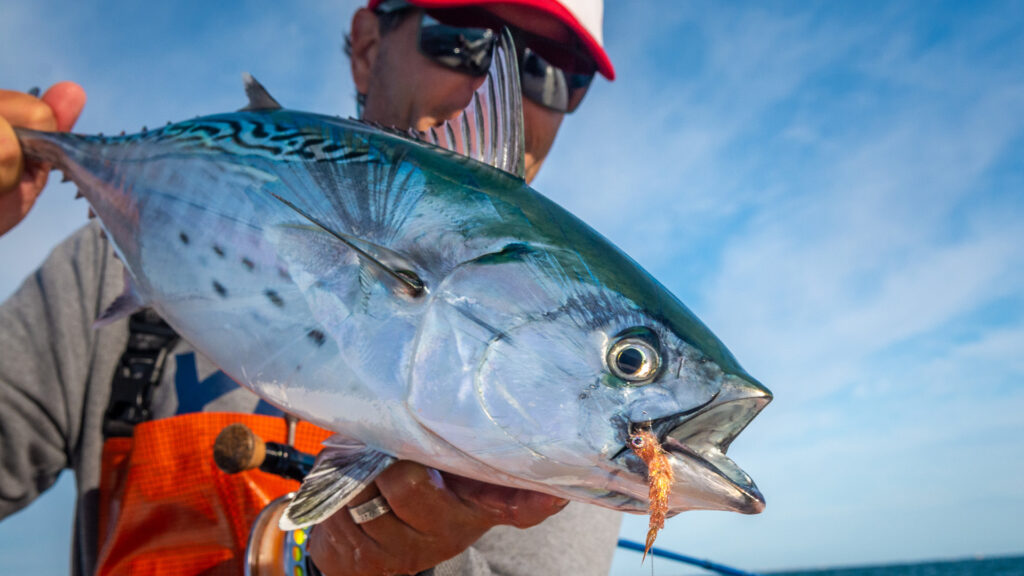Experienced fresh water fly fishers venturing into the salt understandably have questions about leaders, connections, and knots.
Although some big game species may require specialized rigging, striped bass, bluefish, bonito, false albacore, weakfish, redfish, snook and many other small to medium inshore species don’t call for anything terribly complicated. Depending on conditions, you might use something as simple as a three-foot piece of 30# fluorocarbon when fishing around rocks, or a compound 15’ tapered leader, not unlike the design of a trout leader, when fishing bonefish flats. I caught my first fly-rod bluefish nearly 50 years ago, and scores of other species along the length of the Atlantic and Gulf coasts since then. There are no hard and fast rules or formulae, but here are some rigging suggestions that have served me well for decades.
To connect backing to your reel spool, use the Arbor Knot, which is illustrated in many knot books, and demonstrated on internet videos. To connect the backing to the end of the fly line, since I often change lines on various reels, I normally go loop-to-loop, although a nail knot can work fine. Most fly lines now have welded loops, but I have more trust in my own. Simply double the fly line back an inch or so, and tie two or three nail knots around the doubled line with 10lb. mono. (See photos) Coat the knots with Pliobond, Knot Sense, or other flexible cement. Interlock the fly line loop with a surgeon’s loop on the backing.

Clinch to loop, loop-to-loop, and nail knot // Photo: Ed Jaworowski
For the leader, three types of knots will serve almost all your needs: (1) a loop, (2) a mono to mono connection, and (3) a knot for attaching the fly. A loop-to-loop connection or a nail knot are the most widely used to attach the line with the leader butt. For heavier duty, or when the connection will usually not come inside the tip top, I prefer using loop-to-loop, otherwise I may opt to connect the leader to the fly line loop with a clinch knot.
To join various leader sections I rely on one of the three shown here, depending on leader diameters or conditions. The regular surgeon’s knot directs you to go twice through the initial loop you form with the two strands. I strongly advise you to go through three times.

Surgeon’s knot, blood knot, and loop-to-loop. // Photo: Ed Jaworowski
To attach the leader to the fly, see the pictured options. Extensive testing has convinced me that when carefully tied and seated, a clinch knot, (as long as it has sufficient turns and is carefully seated by pulling the standing end) is a bit more reliable than the popular improved clinch. Other options I use are the Becker (aka Orvis) knot, or a non-slip mono loop.

Clinch knot, Becker knot, and the Non-Slip mono loop knot. // Photo: Ed Jaworowski
Some species, like snook and tarpon, call for bite or shock tippets, because of their very course lips or sharp teeth that wear through thin mono. A short length of 30 or 40-pound (I like 50-60-pound for small tarpon) hard nylon or flouro usually suffices. A surgeon’s knot works well, and much better than a blood knot when joining strands of very different diameters. That surgeon’s knot with three wraps works well to join 12# leader up to a 40# bite tippet. If the leader material is less than that, or the shock tippet more, simply double back the leader so it is closer to the diameter of the heavier bite tippet.
I long ago gave up using nylon for bluefish, especially large “slammers”. The larger the blue, the longer he will fight, and he’ll be chewing on that leader the whole time. They’ll bite through hard 60-pound nylon. As for barracuda, I’ve had them sever 100-pound hard mono as cleanly and quickly as a pair of hedge shears. When wire is clearly called for, here are two options. For many years, I have relied on single-strand bronze-colored stainless wire. About four or five inches of no.10 wire works great. Its 130-pound breaking strength may seem like overkill, but thin wire kinks and distorts easily and is difficult to straighten, should it get bent. The heavy wire can be straightened by hand; in effect, it’s like an extension of the hook shank.

Single strand w/ haywire twist // Photo: Ed Jaworowski
For barracuda, sharks, kingfish and such, I recommend multi-strand braided wire, perhaps 12” (or longer). It’s flexible, reliable, quick and easy to use, and turns over more easily when casting than a long strand of stiff, single-strand wire. I generally just carry a spool in my shirt pocket, and add a bite tippet when called for. Be sure it is designated as “knottable” or “tieable”. Avoid the nylon coated braided wire that is designed to be used with crimping sleeves. The nylon shreds easily and fish will generally shy away from it, especially black nylon. The following photos show how to connect it to your nylon or fluoro leader, and how to connect it to a fly. The figure-8 knot looks too deceptively simple, but I have caught many bluefish up to 16-pounds and countless pike to 20 pounds, and never had a failure. Just remember to hold the standing or main part of the leader firmly, and pull on the tag end with pliers to seat it properly. Pulling on the standing line will kink the wire leader.

Multi-strand w/ uni-knot // Photo: Ed Jaworowski

Figure 8 Knot. // Photo: Ed Jaworowski
Some final comments. The best-designed knot in the world is no better than the worst knot, if it isn’t tied and seated carefully. A knot nearly always slips slightly before it breaks, so moisten your knots, tighten them completely and carefully, and test them. Practice at home before you hit the water.

Blog author Ed Jaworowski with a large redfish caught on the fly. // Photo: Lefty Kreh






